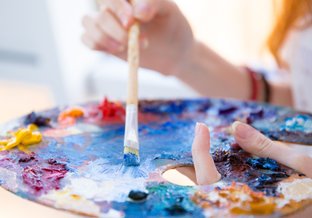Art Therapy.
Art therapy is a form of psychotherapy where expressions of art are seen as a primary form of communication.
You don't need to have any experience or skill with art to benefit from art therapy.
It still involves talking, but doesn't always have to. Sometimes there aren't the words, and art can be helpful for people to explore and express who they are and what they are thinking and feeling.
I provide a range of art materials in the therapy room which can be used at any point in time. Some people like to use art materials each session, other people less often.
Occasionally I might suggest the use of an art material to explore a particular feeling or problem, but clients always decide what they wish to make or not.
Art therapy isn't an art lesson, and as a therapist, I will not judge you or tell you what to do.
Art can sometimes feel pretty scary, particularly if you have not explored art materials for some time, but that is OK, and it is often really helpful to explore the feelings it brings up.
Any art work you make belongs to you. If you want to take it home you can, if you want to throw it in the bin at any time, you can!
Art therapy is confidential; any images you make are treated with the same confidence as anything you say in sessions.
CAT (Cognitive Analytic Therapy)
CAT as a therapeutic model focusses on collaborative work between therapist and client, it looks at understanding and recognising our unhelpful behaviour patterns and aims to try alternatives. It looks at roles we find ourselves in, in relationships and aims to explore, without judgment, how we make our way in the world.
EMDR (Eye Movement Desensitisation and Reprocessing)
EMDR utilises the natural healing ability of your body. After a thorough assessment, you will be asked specific questions about a particular disturbing memory. Eye movements, similar to those during REM sleep, will be recreated simply by asking you to watch the therapist's finger moving backwards and forwards across your visual field. Sometimes, a bar of moving lights or headphones is used instead. The eye movements will last for a short while and then stop. You will then be asked to report back on the experiences you have had during each of these sets of eye movements. Experiences during a session may include changes in thoughts, images and feelings.
With repeated sets of eye movements, the memory tends to change in such a way that it loses its painful intensity and simply becomes a neutral memory of an event in the past. Other associated memories may also heal at the same time. This linking of related memories can lead to a dramatic and rapid improvement in many aspects of your life.
© Copyright. All Rights Reserved.
FOLLOW CYGNUS THERAPY EDINBURGH
On Facebook
To Make an enquiry
please complete the enquiries form.
I will get back to you
as soon as possible.
Or call me on 07415 759 860
I Accept:
Cash or Bank transfer at the
time of your appointment.
Unfortunately I do not have
card facilities.


